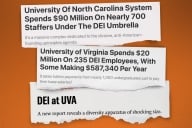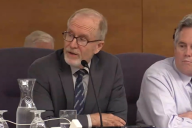You have /5 articles left.
Sign up for a free account or log in.
It's well documented that state appropriations for public colleges and universities have flattened or fallen since the early 2000s, especially when viewed against significant increases in enrollments at the institutions over that time. It is similarly understood that enrollments of out-of-state students have burgeoned over that time period. But are the two trends related?
A new study published in the journal Research in Higher Education (abstract available here) asserts that they are. The research, by professors at the University of Arizona and the University of Missouri at Columbia, examines the relationship between funding for higher education in U.S. states and the levels of nonresident enrollment at public institutions between 2002-3 and 2012-13.
It finds that a 10 percent decline in a state's financial support was associated with a 2.7 percent increase in out-of-state enrollment at its public institutions. The relationship was even greater at public research universities (4.6 percent) and at research-extensive institutions (5 percent).
As is often the case with studies such as this one, the researchers -- Ozan Jaquette, assistant professor of educational policy studies and practice at Arizona, and Bradley R. Curs, associate professor of educational leadership and policy analysis at Missouri -- can't document a direct causal relationship between the cuts in state appropriations and the increase in out-of-state students.
But they were able to control for state- and institution-level factors that tend to affect the enrollment of no-resident students, such as more aggressive recruitment of such students by universities in states with declining college-age populations. Even after controlling for such factors, the scholars "found a strong and significant negative relationship between state appropriations and nonresident enrollment," Jaquette said in an e-mail.
Further, he said, "consistent with the idea that public universities increase nonresident enrollment in response to decline in state appropriations, when we changed the dependent variable to *resident*Did he use the asterisks in writing? Or should this be italicized? freshman enrollment, we did not find a statistically significant relationship between state appropriations and resident freshman enrollment." In other words, enrollments of in-state students didn't similarly rise in response to cuts in state funding.
While some state legislators balk when out-of-state enrollments rise too high or too fast, because of the perception that the incoming students are taking slots away from state residents, public college leaders in many states describe their lawmakers as engaging in a wink-and-nod arrangement in which they acknowledge that it's a comparatively painless way for the institutions to make up for the loss of state funds. (Public college officials also sometimes explicitly link state funding to increases in in-state enrollment, as the University of California's Janet Napolitano has done in debates over state funding there.)
Increases in the number of out-of-state students can also benefit institutions (and states) because many students end up working (and paying taxes) in the states where they receive their bachelor's degrees. "Therefore, nonresident enrollment growth may positively affect state economic development," the researchers write.
Still, the trend is not without its costs, the researchers say.
Another recent paper by Jaquette, Curs and Julie Posselt, an assistant professor of education at the University of Michigan, found that increases in the number of out-of-state students drive down the proportion of low-income and underrepresented minority students at public research universities, since most of the students imported from other states were full-paying (and hence from wealthier families).
More philosophically, they argue, the trade-off of cuts in state appropriations for increased out-of-state enrollment may contribute to the drift toward privatization that many policy makers and others see unfolding in public higher education. "Public universities may treat state budget cuts as the breaking of an implicit contract between the university and the state," they write, "thereby entitling the university to transition from an exclusive relationship with the state to an open relationship that crosses state boundaries."









